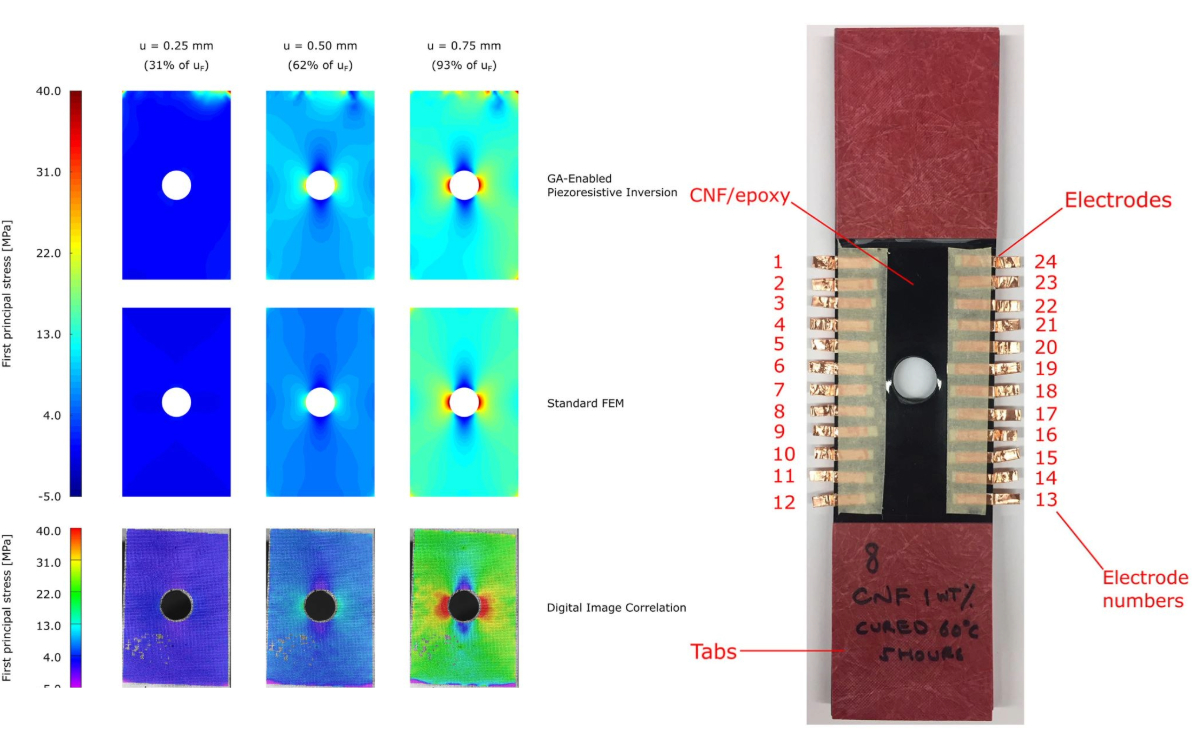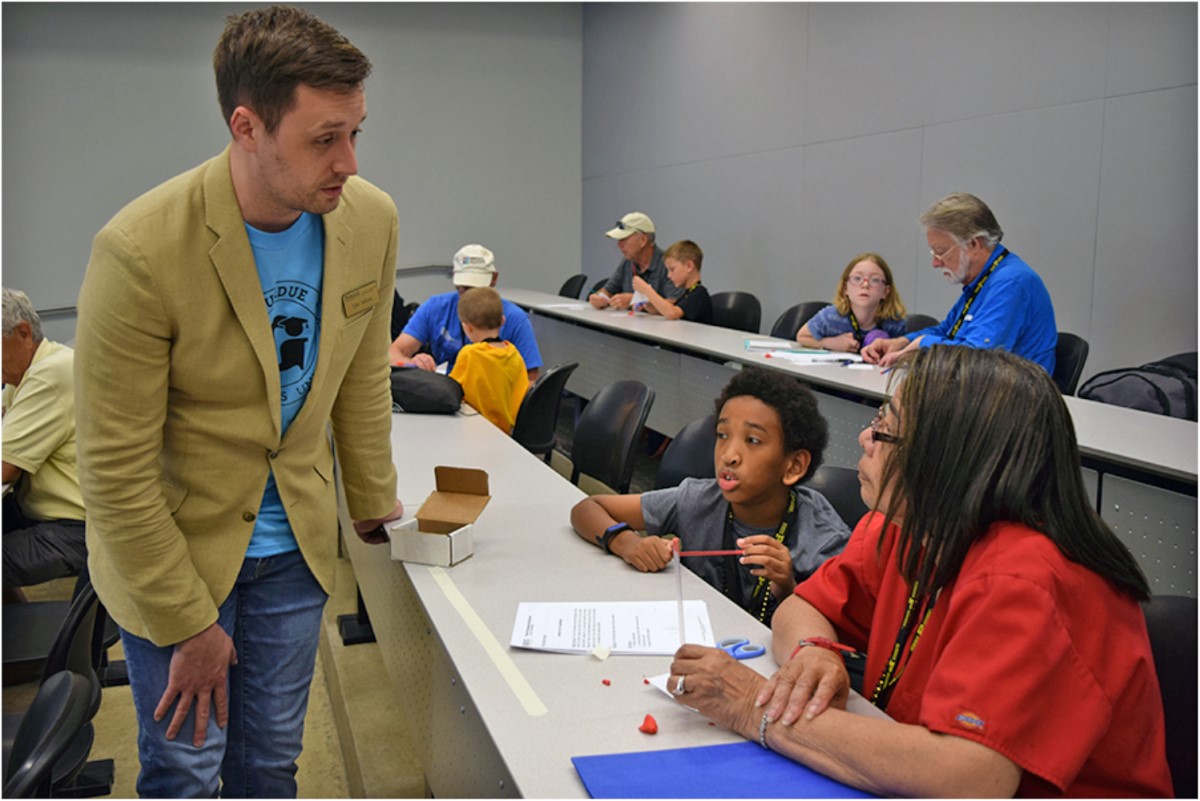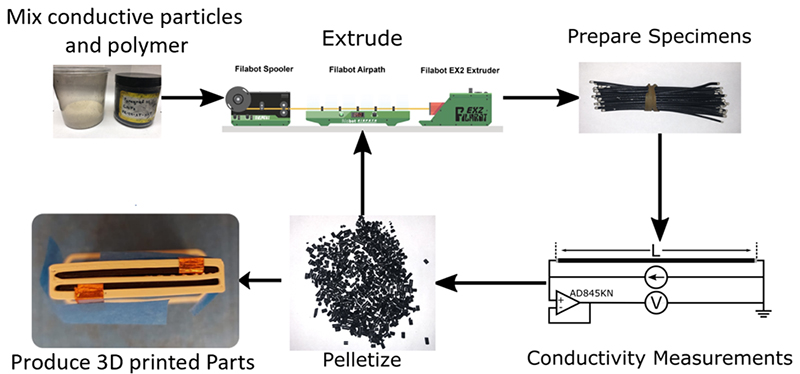
Research into self-sensing materials had begun to stagnate when Tyler Tallman was publishing his first papers in 2013. Back in the early 2000s, the field was abuzz about materials like carbon nanotube polymers, which would change their electrical properties when deformed. These materials showed potential to revolutionize structural sensing: Instead of mounting strain gauges at certain points, structures could be painted with or made of self-sensing materials.
By combining that feature with ongoing experiments in electrical tomography, engineers dreamed of a spaceship with skin-like sensitivity: A tomography map could show the pilot if her ship was bending, stretching, damaged, or worse. No individual sensors required.
But Tallman, associate professor of Aeronautics and Astronautics, says the field didn't make significant moves beyond those foundational experiments. The dream was going stale.
"There were still so many papers doing the exact same thing they did more than two decades ago. Research sponsors are not interested in studying flat plates with through holes or other overly simple conditions. They want to know how we advance this technology to realistic shapes and realistic conditions," Tallman says.

This electrical impedance tomography (EIT) experiment conducted by Tyler Tallman and Hashim Hassan shows conductivity change distributions in a specimen that is under tension. Tallman is finding the correlation between the conductivity change and the physical effects.
"And then we have to say, 'Well, what can we actually do this with information?' Structural engineers are not interested in electrical properties. They want to know stresses, strains, damages, things like that. Mechanical properties. I think that's been where we have made the most contributions in our research group."
Tallman credits Hashim Hassan (MSAAE '17, PhDAAE '21), whose thesis at Purdue helped couple the relationship between electrical properties and mechanical condition. Tallman's group extended that to a variety of materials and looking at more complex shapes like airfoils, tubes, and truss structures. He completed several papers in collaboration with the Air Force Research Laboratory (AFRL) on these topics.
"We're moving past simple specimens, moving past flat plates, and looking into how we actually transition this into practice, he says. I think that's what's attracting the attention of sponsors like the Air Force: We are trying to move this technology away from just being an academic curiosity and into meaningful practice."
Tallman's contributions have attracted serious interest: A three-year, $445,000 grant from the Air Force Office of Scientific Research's (AFOSR) highly competitive Young Investigator Research Program (YIP) supports his proposal on data fusion. The funding has helped him support several grad students to explore the challenge of combining information from many different inputs, extending it specifically to 3D-printed polymer matrix composite materials with self-sensing properties.
It's interdisciplinary work, which Tallman finds energizing: It requires understanding how electrical properties can be embedded in 3D-printed materials, how those electrical properties change with evolving loads, and the inverse mathematics needed to correlate the electrical changes with physical state changes.
His second grant in 2023, worth $510,000 over five years, is more foundational. The National Science Foundations (NSF) Faculty Early Career Development (CAREER) program supported his proposal to dig deeper into what Hassan showed. The results could extend to many materials that exhibit conductivity-deformation coupling.

Tyler Tallman talks rocket design with participants in Purdue's Grandparents University outreach day in 2019. He encourages all his students to participate in outreach through Purdue's Girl Scout Day, Introduce a Girl to Engineering Day and Grandparents University. (Purdue University photo)
"By inverting the relationship between electrical changes and mechanical loading in these materials, it is possible to know the full-field mechanics from only a small number of electrical measurements. This research will discover the basic nature of this inverse problem, which will lead to more accurate, more robust, and faster solutions," he says.
Tallman adds that this technology could also be used in fields like biomedicine, robotics, and geospatial imaging.
With service as a key component of the NSF's CAREER grant, Tallman wanted to use this platform to support women and girls interested in STEM. He has seen how difficult it can be for women trying to succeed in male-dominated fields: His wife, an orthopedic surgeon, faced frequent harassment during her residency training.
"It was just non-stop — from subtle, culturally entrenched things to some grossly overt stuff, not just to her, but to many of the women in her program," he says. "Through all that, she mentioned that having mentors and allies was a thing that really helped her."
When he came to Purdue, Tallman wanted to contribute to programs that offer that support. He approached the Society of Women Engineers (SWE) about bringing aerospace-themed activities to their Girl Scout Day program.
"He expanded his engagement in outreach to girls through the Women in Engineering (WiE) program," says Beth Holloway, director of Women in Engineering and professor of engineering practice in mechanical engineering. "We've continued to work with Tyler because of his positive attitude and his dedication to outreach. He is exactly the kind of faculty partner that WiE needs and appreciates!"
Tallman's NSF proposal included partnering with SWE and WiE to integrate self-sensing mechanics with additional outreach activities in the greater Lafayette area.
"The goal is not to turn every outreach student into an engineer," he says. "Although that would be fantastic, we just want them to feel like it's okay for them to study engineering. There should be no barrier to it just because you're not a guy."

Tyler Tallman, together with associate professors Brittany Newell and Jose M. Garcia-Bravo in the School of Engineering Technology, produced a patent-pending wet-mixing method to evenly add particles to filament used in 3D printers.
"A limitation of application of 3D printed parts has been in their durability," Newell said. "With this development, we can continually monitor the structural health of the part with the sensor embedded in the print."